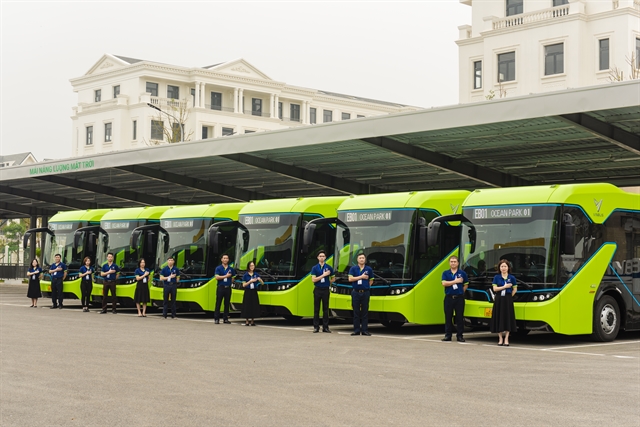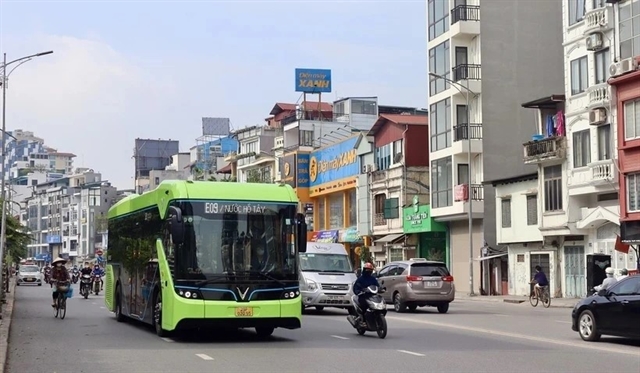The trend of transitioning to electric vehicles (EVs) in Việt Nam is becoming increasingly evident, with a clear focus on sustainability, cost savings and enhanced user experience, according to local car experts.

HÀ NỘI — The trend of transitioning to electric vehicles (EVs) in Việt Nam is becoming increasingly evident, with a clear focus on sustainability, cost savings and enhanced user experience, according to local car experts.
EVs not only help protect the environment by reducing emissions but also offer significant economic benefits for both individuals and businesses, they noted.
For individual consumers like Nguyễn Văn Xuyên, who switched from a petrol car to an electric vehicle (the VF 5 Plus), the benefits are tangible. Not only did he enjoy financial incentives such as 100 per cent support for registration fees and discounts, but he also benefited from free charging and parking within Vingroup’s ecosystem.
Xuyên's monthly operating costs are significantly lower, with electricity charges being far cheaper than fuel. In addition, the electric car’s long maintenance intervals (12,000km) further reduce overall costs, making it a cost-effective choice in the long run.
On the business side, electric vehicles are proving to be a wise investment for companies like En Vang Taxi. Nguyễn Văn Định, chairman of En Vang Taxi, highlighted that their customers have shown positive feedback, appreciating the modern and environmentally friendly vehicles. Moreover, the cost savings on energy have been substantial. With the cost per kilometre for electric vehicles being significantly lower than that of petrol or diesel taxis, En Vang Taxi has been able to save on operational expenses, which is essential for long-term business sustainability. En Vang Taxi is aiming to increase its fleet of electric vehicles, with a target to reach at least 50 per cent of their fleet as electric vehicles by 2025.
Electric and hybrid vehicles are projected to continue experiencing strong growth in 2025 and the following years, with an expected growth rate of 25-30 per cent in 2025, and gradually accounting for a larger share of the total car sales in Việt Nam.
According to the Market Research Department at Oto.com.vn – a subsidiary of Nextgen Vietnam JSC, in previous years, 'green' vehicles accounted for only a small portion of the Vietnamese car market. However, in 2024, this segment reached a sales volume of 97,000 vehicles, including 87,000 electric vehicles from VinFast, 5,350 hybrid vehicles from Toyota, 2,515 hybrid vehicles from Suzuki, and 1,905 hybrid vehicles from Honda.
According to the Ministry of Industry and Trade, it is forecast that by 2050, only electric cars will be on the road with an estimated number of 9.6-10.5 million units.

Coordination in multiple sectors needed
The transition to electric vehicles in Việt Nam is a complex and multifaceted process requiring a coordinated approach across multiple sectors, according to World Bank experts.
They emphasise the necessity of establishing an inter-ministerial governance structure to direct and synchronise efforts within the entire ecosystem. Such a structure will ensure seamless policy implementation and alignment among stakeholders, including government agencies, financial institutions, private enterprises and individual consumers.
A systematic transition of this scale demands the participation of both public and private sectors, yet the primary responsibility falls on the Government. Effective coordination is needed to optimise stakeholder engagement, ensuring that policies and incentives resonate throughout the economy.
The Government must take the lead in setting strategic objectives, implementing regulatory frameworks, and fostering an environment conducive to EV adoption.
In addition to technical analyses, comprehensive policy recommendations should be tailored to each major transport segment. Public transport, commercial logistics and private vehicle ownership each present distinct challenges in charging infrastructure requirements, investment needs and consumer adoption rates. Identifying and addressing practical barriers specific to different vehicle types is critical to maintaining momentum in the transition process.
To accelerate the transition to electric buses, the Government should consider banning new diesel buses, optimising bus routes and ensuring the development of battery purchasing and warranty contracts. Performance-based contracts can help improve city bus services.
Việt Nam should also focus on establishing technical specifications for electric trucks and minibuses, assess demand for freight transport, and pilot electric minivans for government freight services. They noted that the public charging infrastructure needs to be expanded rapidly. Between 2025-2027, this should focus on major cities, with expansion into non-urban areas planned for 2027-2030. By 2035, a robust charging network should be in place across both urban and non-urban regions. — VNS





